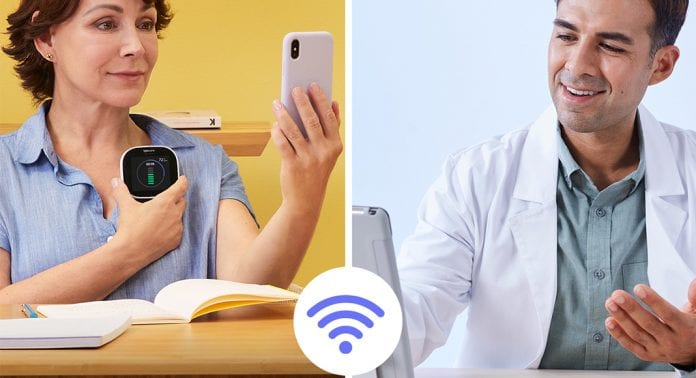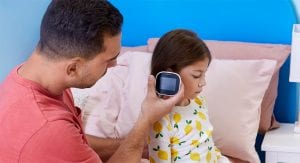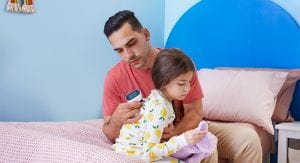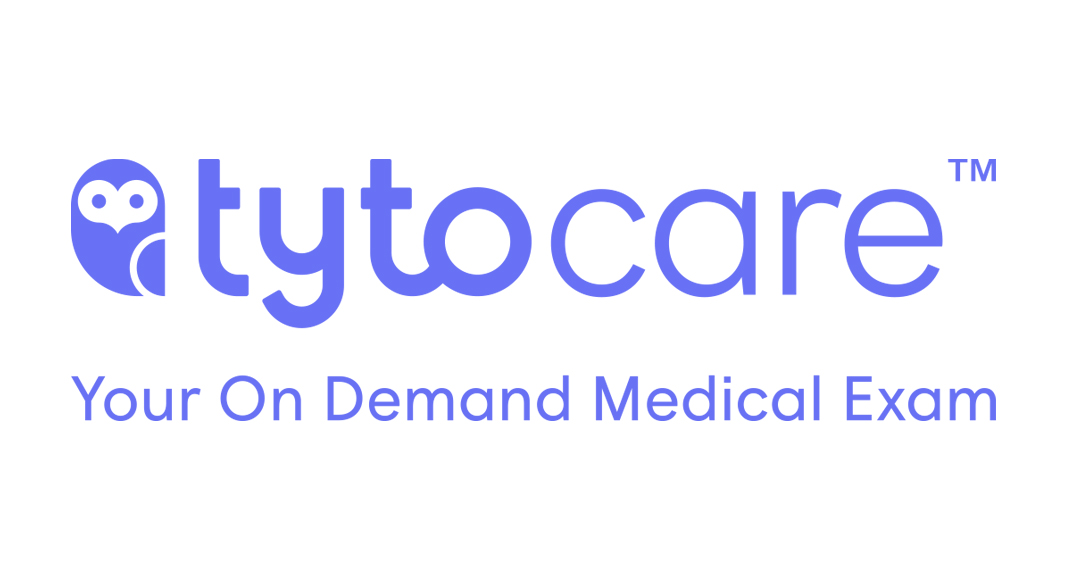
Just a year ago, teleconferencing was a tool almost exclusive to business users. Video added the personal touch that went beyond faceless phone calls and helped bridge the gap for conversations with colleagues and customers. For the rest of the world, live video was most often used, well, to talk to Grandma.
Fast forward. Today, as we remain mired in the COVID-19 pandemic, entire school systems have turned to the video screen. Online conferences attract thousands of attendees visiting virtual booths, listening to online presentations, and interacting in real-time. And of course, the medical community has now fully embraced the concept of remote medical care as an effective strategy to solve a dozen new challenges.
But while telehealth has never been more relevant, not all telehealth solutions are created equal. In fact, most platforms today focus on delivering only a basic, on-screen – but hands-off – discussion. The patient can describe symptoms and perhaps show them to the clinician if the symptoms are external and easy to see. However, few doctors (or patients, for that matter) will truly trust a diagnosis or treatment plan based on an exam without the collection and review of accurate exam data. If the doctor cannot hear the patient’s lung sounds, look inside the ear canal, or throat, or listen carefully to the subtle rhythms of a heartbeat, what confidence can he or she have in drawing conclusions?
As telehealth providers and their customers hoped for more “hands-on” solutions over the past decade, telehealth began to evolve, garnering greater acceptance as it matured. Healthcare providers began to carefully and gradually experiment with telehealth as a next-generation paradigm.
Then COVID-19 changed everything. In short, for many patients and providers, telehealth is suddenly and irrevocably becoming the norm, not a future innovation to consider. Healthcare providers worldwide are under pressure – like never before – to do the impossible: treat patients at a faster pace and more efficiently while trimming costs, maintain staff morale and health, and somehow keep client satisfaction at or above current rates.
The TytoCare hardware and software platform offers three products that address the core needs of remote medical care as it becomes more and more common across the globe: TytoHome for individual use, TytoPro for on-the-go medical professionals, and TytoClinic, currently available in the US, which serves as a stand-alone exam centre wherever needed.
The palm-sized, FDA- and CE-approved Tyto device features a thermometer, otoscope for ear exams, stethoscope for heart and lung sounds and heart rate measurement, tongue depressor for the throat, and camera for the skin. It uses an app to perform exams guided by either advanced Artificial Intelligence (AI) independently, or by the doctor performing a live exam. Typical use cases include diagnosing acute conditions such as ear infections, sore throats, fever, cold and flu, allergies, stomach issues, upper respiratory infections (especially relevant in COVID-19 monitoring), and rashes. In 2019 alone, TytoCare performed more than 450,000 telehealth examinations, providing safe, convenient, clinical-grade care to over 200,000 people around the world.
It uses an app to perform exams guided by either advanced Artificial Intelligence (AI) independently, or by the doctor performing a live exam. Typical use cases include diagnosing acute conditions such as ear infections, sore throats, fever, cold and flu, allergies, stomach issues, upper respiratory infections (especially relevant in COVID-19 monitoring), and rashes. In 2019 alone, TytoCare performed more than 450,000 telehealth examinations, providing safe, convenient, clinical-grade care to over 200,000 people around the world.
Health providers, health insurance companies, hospitals, clinics, businesses, schools, and care homes around the world are leveraging the TytoCare remote exam system to deliver on the full promise of telehealth by driving efficiency, cutting costs, and yes, delighting patients with immediate, reliable care.
Below, we would like to briefly give you a glimpse into some of our game-changing, successful implementations.
Trimming valuable time from physicians’ visits
SWICA, one of Switzerland’s largest health insurers, had long recognised a pattern: the vast majority of non-urgent care visits result in non-chronic, non-dangerous diagnoses such as sore throat, common cold, ear infections, and the like. A typical visit to a clinic involved significant time during which the doctor would conduct a battery of routine basic tests, review the data, and finally present a diagnosis. Its telehealth subsidiary, Sante24, decided to expand their phone-based visits and leverage TytoCare’s telehealth platform in a new workflow to optimise the process.
Patients independently perform a comprehensive at-home physical exam – just like the one they get from a doctor in the clinic – following step-by-step, audio-visual guidance built right into the Tyto device and mobile app. These user-friendly instructions combine voice, visualised animation, and artificial intelligence for ease of use, especially for the elderly and less technically inclined. Tyto’s AI capabilities verify the recorded exams were performed with diagnostic quality, supporting the doctor to achieve a diagnosis. The key innovation is that the recordings are then transmitted online to a first-tier group of triage nurses who, in addition to confirming that the data is clear, conduct an initial patient interview and, consequently, a first anamnesis. If necessary, the data is then forwarded to the next level – the physician – to interpret the exams in the context of the patient’s history. The physician then contacts the patient again to decide whether it is possible to make a diagnosis and treat the patient or to conduct an additional online visit to finalise the treatment.
Protecting patients and doctors
On the other side of the world, Thailand faces a similar challenge. Like many healthcare providers, Samitivej hospitals and the BDMS group – consisting of 48 internationally recognised hospitals – was battling COVID-driven increases in doctor-to-patient ratios. In addition, much of Thailand’s population lives in rural areas where travel is rough, long, and often involves public transportation – a high-risk environment of packed buses, trains, and cabs.
Upon arriving at a clinic, patients often find themselves in crowded waiting rooms, which in themselves present yet another environment ripe for contagion. Prior to the COVID-19 outbreak, Samitivej had already been in the middle of a pilot program with TytoCare, using hundreds of Tyto devices with their own staff. When the pandemic broke out, they immediately made the devices available to the Thai government for distribution across the country, and are in the process of adding more. As a result of the TytoCare partnership, Samitivej was not only able to better safeguard their patients, but saw a dramatic reduction in the number of their own staff going into isolation after catching the virus from patients, as well as a drop in the overhead expense of managing complex, safety-driven logistics and in the costs of specialised personal protective equipment (PPE) needed for day-to-day in-person treatment.
Expanding Access to GPs for Seniors
Qare, one of France’s largest and fastest-growing telemedicine providers, saw a unique opportunity to connect patients with general practitioners by integrating TytoCare’s TytoPro devices into its telehealth platform. French residents can be examined by a remote GP using TytoPro in any of more than 100 pharmacies distributed across four different pharmacy chains.
The offering has been a boon to residents in rural areas, where reaching a GP had long been more difficult than in urban locations. Among the biggest beneficiaries have been seniors. While home usage of Qare’s telehealth platform without Tyto attracts young adults, the joint offering has attracted an older population; those between the ages of 50 and 80 account for 38% of pharmacy visits since the two companies launched their partnership. Since June, the number of pharmacy visits has more than doubled, increasing by a factor of 2.5.
Bringing virtual care to sick children
Bradford, England is recognised as the United Kingdom’s youngest city, with nearly a quarter of its 528,000-strong population under the age of 16. That made the city a fitting site for TytoCare’s first-ever UK partnership. Together with Bradford Teaching Hospitals NHS Foundation Trust and the Trust’s Ambulatory Care Experience (ACE) team, Tyto is treating sick children from the comfort of their own homes. Not only does the offering prevent unnecessary hospital admissions, but it also enables efficient prescription fulfilment by allowing clinicians to link to local pharmacies using TytoCare – ensuring that children’s diagnoses and treatment can be managed entirely from home.
Together with Bradford Teaching Hospitals NHS Foundation Trust and the Trust’s Ambulatory Care Experience (ACE) team, Tyto is treating sick children from the comfort of their own homes. Not only does the offering prevent unnecessary hospital admissions, but it also enables efficient prescription fulfilment by allowing clinicians to link to local pharmacies using TytoCare – ensuring that children’s diagnoses and treatment can be managed entirely from home.
Doubling down at the clinic and at home
Clalit is Israel’s largest health system (and the second-largest health maintenance organisation (HMO) in the world), with 14 hospitals, 1,400 clinics, and 4.5 million members representing 25 million annual primary care visits. Clalit has been an active partner in offering telehealth to all its members. In the past two years, it has distributed tens of thousands TytoHome devices to patients for home use, and are rapidly increasing comprehensive usage as members become accustomed to the convenience and efficacy of the process. The numbers tell the story: while the average visit time in Israel is eight minutes, TytoCare visits last about four and a half minutes. 93% of visits do not require a physical visit, and 92% of patients complete an exam with no technical problems whatsoever. Most importantly, members report a 94% satisfaction rate when surveyed.
But Clalit hasn’t stopped there. The arrival of COVID-19 made Tyto indispensable. The news images of overcrowded, COVID-stricken hospitals worldwide have been harrowing, with every patient-facing medical professional covered from head to toe in multi-layered suits, gloves, and masks. And for good reason – the loss of a doctor or nurse to a two-week isolation period or longer-term infirmity increases the stress on the rest of the organisation. Clalit recognised that they could minimise their staff’s exposure during routine, ongoing testing of the Coronavirus’ flu-like symptoms by simply transferring the equipment to the other side of the partition. That means more and more patients now test themselves using TytoCare, improving safety for all.
Because health isn’t a game
The University of Miami’s Medical Center faced an interesting conundrum this summer. The school wanted to allow its sports teams to train over the summer and as the fall semester began, but the close contact of the players put the teams at risk. In addition, there were fellow students, trainers, faculty (some of whom are older and in high-risk categories), and university operational staff to protect. The Medical Center predicted that, based on statistical probability and current patterns, they were likely to face a real problem, which was the athletes who could easily be asymptomatic and could quickly spread the virus to the team and beyond, overwhelming the hospital’s capacity and endangering the health of the entire campus. The univeristy decided on a proactive approach – to keep them from having to visit the campus for medical exams, athletes and trainers were given TytoCare devices if they met any of the following conditions:
- A positive test for COVID-19
- A sore throat, fever, or other symptoms suggestive of the virus
- Diabetes, asthma, or a similar underlying medical condition that puts someone at significant risk for the disease
- Exposure to individuals who have tested positive or those who need to be monitored or quarantined because of travel
As the pilot has only just begun, hard numbers are still on the way, however, the university has thus far managed to control its COVID-19 spread, and both patients and medical professionals monitoring the data have reported overwhelming satisfaction with the process.
Under-served remote, rural populations
The Chilean village of San Bernardo is located near the country’s capital, Santiago. Its rural neighbourhood is located high in the mountains, which creates a challenge for residents who need to reach medical facilities; most neglect clinic visits until they face a clear crisis.
In a country facing an ongoing obesity and diabetes epidemic – not to mention COVID-19 – timely, routine check-ups could mean the difference between life and death. The local government asked VitalTec, TytoCare’s local distributor, to help. Over a three-day period this September, a team of nurses went door to door in the village, visiting over a hundred families in an initiative called Spreading Health. The team used TytoCare’s remote examination solution to examine children, adults, the elderly, and patients with chronic problems who would otherwise have faced waits of up to a year to see a doctor. Residents were stunned by the “special attention” and delighted to eliminate the arduous journey down from the mountains. Especially as the programme costs less than bringing physicians up into the mountains, San Bernardo’s health administration is looking forward to expanding it to other remote villages.
As these illustrations make clear, each region, healthcare provider, and patient population presents unique challenges in the COVID-19 era. As each challenge is confronted in a creative, dynamic manner, the medical community is creating an entirely new culture of patient engagement, and TytoCare is proud to play a central role in the process. Once the pandemic has subsided, the lessons learned, and new best practices generated along the way will continue to propel the sector toward a more efficient, innovative, and patient-friendly future.







